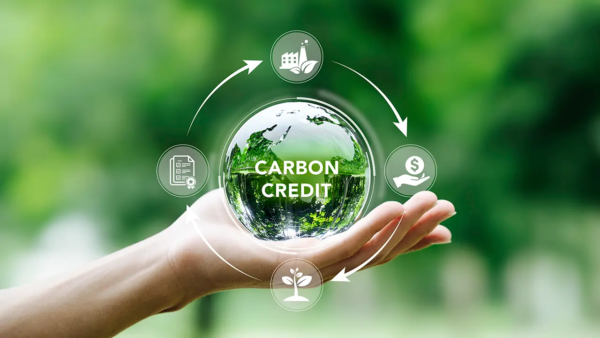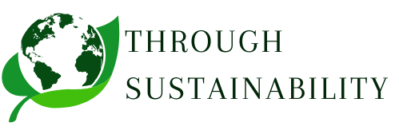Carbon Market (CM) valued at USD 12.4 billion in 2023 is a prominent global financial mechanism adopted by countries to combat Climate Change. Through this mechanism, buyers are offsetting their greenhouse gas (GHG) emissions by acquiring carbon credits from entities that are actively reducing or moving GHG emissions. In a nutshell, CM facilitates buying and selling of carbon credits.
[One tradable carbon credit = 1 tonne CO2 or the equivalent amount of a different GHG reduced, sequestered or avoided]

Carbon Market is broadly divided into two categories – Compliance Carbon Market (CCM) and Voluntary Carbon Market (VCM). While CCM is regulated by mandatory regional, national or international carbon regulatory bodies, VCM involves trading of carbon credits on a voluntary basis. Some of the world’s CMs are Clean Development Mechanism (CDM), European Union’s Emissions Trading Systems (EU-ETS) and India’s own upcoming Carbon Credit Trading Scheme (CCTS). Infact, the World Bank has projected that CM can generate up to USD 250 billion annually through implementation of various climate actions, by 2030.
Carbon piracy within carbon markets
On the contrary, the growing trend of Carbon Market has also been inviting heavy criticism from critics who consider it as a mere “greenwashing” sham. It is being argued that CM is actually an arrangement to offset GHG emissions rather than to curb it. Furthermore, the absence of formal regulations and legal frameworks in place is leading to forced displacement of indigenous communities in different parts of the world. CM is thus seen as systematically violating human rights and giving rise to ‘Carbon Piracy’.
What is ‘Carbon Piracy’ one may ask? Carbon Piracy is again, another mechanism to facilitate transfer of rights and resources from biodiversity rich countries/regions through leveraging non -English communities, to entities known as Carbon Pirates. In the VCM especially, REDD+ projects have caught the attention of such carbon pirates. They have been severely criticized for influencing unsuspecting non-English speaking indigenous people to sign on legal documents written in English and invading their territories.
Furthermore, with the increasing demand for carbon credits in the market, fraudulent activities have also seen a surge in carbon trading. Some of these illegal activities include generating false credits, double counting carbon credits by claiming emission reductions more than once and exaggerating figures for emission reductions.
A 2021 study by the Rights and Resources Initiative of McGill University found that many carbon sinks targeted by offsetting schemes are located on lands where indigenous or local rights have not been secured. This study covered 31 countries across Africa, Asia, and Latin America, which collectively holds 70% of the world’s tropical forests and the majority of nature-based emissions reductions and carbon offset opportunities. However, only a few countries have created the necessary conditions for fair, effective, and transparent carbon or REDD+ transactions.
Of the 31 countries in the CM scenario, only 3 countries fully recognize indigenous community rights to carbon management. 7 other countries namely, Bhutan, Fiji, Nepal, Nicaragua, Tanzania, Vietnam and Zambi have ambiguous legal frameworks that could be interpreted to suit community carbon rights.
Way Ahead
While Carbon Market offers a promising method for reducing GHG emissions and fostering climate action, its effectiveness depends on how well it is managed and how inclusive it is, especially in REDD+ projects. When properly designed and managed, CM can drive significant environmental benefits and incentivize the protection and sustainable management of forests. If implemented correctly, CM could incentivize governments to advance the recognition of indigenous and local community rights and enhance governance across tropical forest areas. Additionally, carbon trading could increase financial flows to communities for forests protection and conservation, thereby creating improved livelihoods opportunities.
To avoid potential pitfalls, it is essential for all carbon finance stakeholders to adopt high-integrity, rights-based approaches for securing the legal rights of indigenous and local stakeholders. These communities must also be able to fully exercise and enjoy their rights to self-determination, full and effective participation, due process, and compensation. Additionally, it is crucial to establish a transparent benefit-sharing mechanism developed in collaboration with all stakeholders’ groups to fairly compensate land and forest resources rights for their contributions to GHG mitigation.
On the positive side, a number of innovations and strategies have been built to address the loopholes in the CM. For instance, blockchain technology enhances transparency by preventing double counting and providing a clear, tamper-proof record of transactions. Third-party verification organizations like Verra and Gold Standard are regularly updating their methodologies for improved accuracy and credibility. By integrating these advancements with robust rights-based approaches and recommendations mentioned above, Carbon Market can fulfill its promise of supporting both environmental and social sustainability, and subsequently, ensuring fair benefits to indigenous communities and to their lands.

